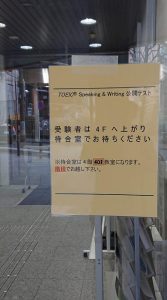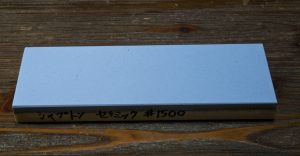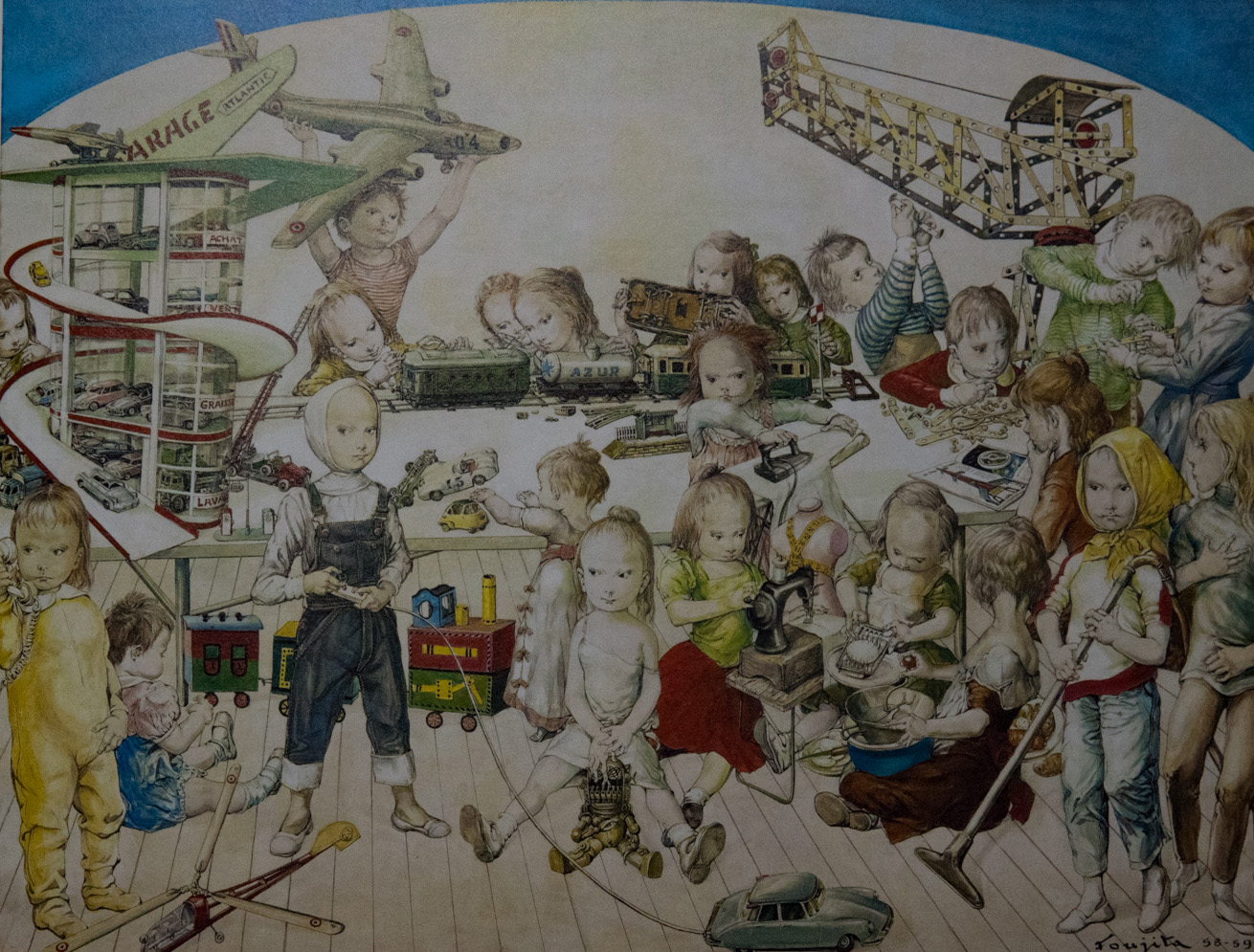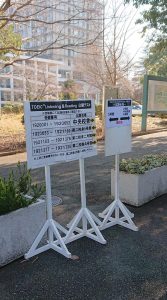 TOEICのSpeaking & Writingのテストを終了。先週がL&Rで2週続けてのTOEICで中々ハードです。会場は第1回目の受験と同じ、京急川崎駅近くの外語学校です。
TOEICのSpeaking & Writingのテストを終了。先週がL&Rで2週続けてのTOEICで中々ハードです。会場は第1回目の受験と同じ、京急川崎駅近くの外語学校です。
今回スピーキングは前回よりはかなりマシで後半の60秒しゃべらないといけない2問も時間が余ることなくむしろ足らない位で、十分しゃべれました。前回つまづいて途中でしどろもどろになった、ある問題を解決する提案は、「オフィスの紙のサプライヤーが突然15%の値上げを通告して来た。予算は決まっていて値上げは受け入れられない、どうしよう」というもので、そんなの社員を集めて相談するような話ではなく、さっさと別の業者を探せばいいだろうと、インターネットの価格比較サイトを使ったら、とか適当に述べて問題無し。最後の問題も問いが何だったか忘れてしまいましたか゛まあまあしゃべれて、点は前回よりは間違いなくいいと思います。
ライティングも大きな問題はありませんでしたが、最後の30分かけてのエッセイでは、最後にある個所をより良い表現に修正しようとしていて、残り時間を見てなくて、修正しきれなくておかしな表現が残ってしまいました。しかしお題は「就職希望者への面接を電話で行うことをどう思うか」で、全部で380語のエッセイ(要求は最低300語ですが、多少長いくらいが点数がいいと言われています)が書け、理由も3つ挙げそれぞれに具体的な例もつけたので、出来は悪くないと思います。
まあトータルでまずますです。今考えると前回の受験は準備不足だったと思います。
カテゴリー: English
TOEIC L&R 第237回を受験
第237回のTOEIC L&Rを受けて来ました。通算7回目の受験です。また前回が10月で、こんな短い間隔で受けたのは初めてです。目的は前回のリスニングのリベンジです。今回席が中央の前から2番目というベストポジションで、なおかつ音声の再生機器がいつものラジカセではなく、比較的大きめのスピーカーがついた専用の再生機でした。それもあってか、リスニングはPart 2の問いに対する3択で答えに迷うのが2問ありましたが、公式問題集(2018年10月10日発売の4)のTest 2で非常にトリッキーな問題が出ていたPart 4については今回は比較的平易でした。多分前回よりはいいと思いますが、自己ベストの480に達したかは微妙です。
リーディングも前回とほぼ同じ位の感触で、一応7分ぐらい余して全問解答し、Part 5の30問全部を見なおすことが出来ました。しかし前回は満点の一歩手前の490点だったので今回そこまで取れた自信はありません。
トータルで前回よりはいいと思いますが、自己ベストの965点には多分達していないかな、という感じです。
ちなみに会場は4回目くらいの明大の生田キャンパスです。実はここは戦争中に軍の登戸研究所があった所です。そうです、あの珍兵器の「風船爆弾」を開発した研究所です。もし資料館みたいなものがあるのなら、いつか訪問してみたいです。
New Year’s traditions in Japan
The following is my essay that I wrote as an assignment for an English school AEON:
Topic: New Year’s traditions in Japan
Style: Casual
There were a bunch of rituals, ceremonies, and customs related to New Year’s holidays. Most of them are currently lost in many families, but there is one area where a long tradition is still vital: food. The most important special food for a new year is mochi, or rice cake. Mochi is made from a special type of rice that is stickier than the usual type. We steam that rice and put it in a stone bowl and hit it by wooden beetles for say, 10 to 15 minutes. The rice is crushed enough to become like a pudding. Then we pick some apart and make it round (the way in the western part of Japan) or cut it with a big knife (the way in the eastern part of Japan). While the form of mochi in the western part of Japan is round, it is rectangular in the eastern part. The round form was the original, but the eastern type rectangular form was introduced to cope with increased population in Edo (the former name of the Tokyo city) to save time. Since I was born in Yamaguchi prefecture that is located in the west end of Honshu island. I was surprised very much when I saw rectangular mochi in Tokyo for the first time.
There are several ways to cook and eat mochi, but the most typical and important dish to use mochi is zoni, special soup with mochi. Zoni is prerequisite for the first three days of the New Year for breakfast. I just mentioned the difference of the form of mochi, but there are tens of hundreds of ways to cook zoni. When a newly married couple, each coming from different areas in Japan, holds a New Year ceremony together for the first time, one of the most troublesome things is how to cook zoni. Each has a completely different image for zoni, and since zoni is a very special and important dish for a New Year, it may cause a lot of trouble between the couple. Not mentioning the form of mochi, there are also two ways to prepare mochi for zoni: to bake or to boil it. There are also several types of soup such as soy source based, soy bean paste (miso) based, and in some limited area they use ‘sweet’ soup using red bean paste.
When I was living in Tokushima, there was an exhibition in a local museum regarding the types of zoni in the Tokushima prefecture. Since Tokushima (Awa) was governed by Hachisuka family came from Aichi prefecture, there are some families that use rectangular mochi while round mochi is popular in Tokushima which locates in the western part of Japan. There were actually almost forty or fifty different types of zoni in the prefecture. One thing that surprised me was that there are some people living in deep mountain area who eat soba noodle instead of zoni since they cannot plant rice because of cold weather.
Now, I usually spend New Year holidays travelling. It is always interesting to try a new type of zoni in different areas.
How do you feel about working conditions in Japan?
The following is my essay that I wrote as an assignment for an English school AEON:
Topic: How do you feel about working conditions in Japan?
Style: Formal
(Please note that I am entitled to work as a consultant for Labor and Social Security issues since I passed the examination of Sharoshi in 2010. Labor problems are a part of my specialty.)
On December 25, 2015, on Christmas day, Matsuri Takahashi, a 24-year-old lady working at Dentsu, one of the biggest advertising agencies in Japan, committed suicide because of too much time spent working at the company. Such death is called “Karoshi” (overwork death) in Japan. Very surprisingly, this is the second time Dentsu forced one of their employees to commit suicide. The first incident happened in August 1991, and a 24-year-old (the same age as Ms. Takahashi, very coincidentally) man committed suicide because of too much working time (it reached more than 300 hours monthly). The word “Karoshi” was coined because of this former incident and it was the first case that Supreme court acknowledged the responsibility of the company for the management of long working hours expected of its employees. Dentsu eventually paid 168 Million Yen ($1.5 Million) to the bereaved family. That high amount of money, however, was not enough for the company to change the working “culture” in it and it repeated the unhappy incident again 24 years after the first one.
We can see some characteristics in these incidents of Dentsu company:
(1) Working so long is quite normal in the company. There are few people in the company who see the situation abnormal and try to change it.
(2) New hires tend to become victims of this forced long working hours.
(3) It is difficult to see that the company tried to evaluate its employees by their productivity.
Dentsu is just the tip of the big iceberg, and there are tens of thousands of companies who are akin to Dentsu. While many workers are spending so many hours in their offices, the labor productivity in Japan is quite low, alleged to be around two thirds compared to the ones in Germany or in France. It is the lowest among G7 countries.
It took more than 100 years for workers in Europe to win “an 8-hour workday” since Robert Owen first insisted it in 1817. It is crucial for most office workers in Japan to keep good work life balance and to strive for a better ability utilizing free time in order to survive in the era of AI and robots.
A person I admire
The following is an essay that I wrote for an English school AEON as an assignment of writing:
Topic: A person I admire Style: Casual
Hiroshi Orihara, a professor emeritus of the university of Tokyo, is a person I admire and respect. He was born in 1935. He is a famous researcher of the sociology of Max Weber. In 1968, when he was an assistant professor at the Komaba campus of the university of Tokyo, he protested against the university regarding a unwarranted suspension of a student in the literature department and declined to restart lectures for several years. What he criticized harshly at that time was dual attitude of the university’s professors who teach in one side scientific approaches to students and do not follow those scientific principles in another side; in their real lives. (The student of the literature department was suspended by false accusation that he used some violence against a professor which he instigated. But the truth was, the professor tried to drag him out of a room and the fact that he resisted against that was interpreted falsely. Mr. Orihara tried to find the hidden facts by a kind of scientific approach, but the university ignored his protest and the suspension was not changed eventually.)
In his study of Max Weber’s sociology, his main achievement was that he studied Max Weber’s one of main works named “Economy and Society” very precisely spending 10 years and showed one very strong hypotheses for the correct edition. (I joined this study in the first two and half years when I was a university student). In this giant work of Max Weber, there is a famous edition problem. He started to write this book as an inclusive textbook of economics and sociology in 1910. He was forced to stop writing because World War I started in 1914. After the war, he tried to revise the old drafts and also tried to make some additions, but since he suffered from Spanish Flu, he died in 1920 and could not finish the work. After his death, his wife Marianne Weber tried to rearrange the whole drafts based on her own judgement. Her edition was criticized very harshly by some scholars later, and controversies for the correct arrangement of the drafts has been still continuing. Mr. Orihara joined these controversies from Japan and criticized German scholars who edited the complete works of Max Weber, published by Mohr Siebeck.
What I plan in the near future is, to publish “Economy and Society” in the orders based on Mr. Orihara’s hypotheses. (Please note that Max Weber’s copyright expired in 1990.) I have already prepared the web site for this project: https://max-weber.jp/
Since Mr. Orihara is now 83 years old, I must be hurry.
シャプトン砥石を水に長時間漬けるとどうなるか実験
 シャプトンの昨日届いた1500番のセラミック砥石(マグネシア系)について、ちょっと使う気が失せたので、この際マグネシア系がどの程度水に弱いのか調べるために、一晩水に漬けて放置しました。大体7時間半です。結果として、見た感じの変化はほとんどなく、クラックや剥がれも発生しませんでした。ただ、やはり硬度は落ちている感じがあり、試しにアトマエコノミー(ダイヤモンド砥石)で角部をこすってみたら、結構簡単に削れました。おそらくこういう吸水した状態で刃物を研ぐと、ぼろぼろいきそうな感じです。実際に研いでみれば良かったんですが、朝で時間がなかったのでそこまでしませんでした。まあこの結果からは普通の人造砥石のように使う前に15分くらい水に漬けても、そこまでひどいことにはならないのではないかと思います。ただ注意点は今回テストしたのは5mmの砥石層に15mmの補強層が付いたタイプであり、15mm全体が砥石層で補強がない「刃の黒幕」シリーズが、長時間水に漬けてトラブルがない、という保証にはならないと思います。
シャプトンの昨日届いた1500番のセラミック砥石(マグネシア系)について、ちょっと使う気が失せたので、この際マグネシア系がどの程度水に弱いのか調べるために、一晩水に漬けて放置しました。大体7時間半です。結果として、見た感じの変化はほとんどなく、クラックや剥がれも発生しませんでした。ただ、やはり硬度は落ちている感じがあり、試しにアトマエコノミー(ダイヤモンド砥石)で角部をこすってみたら、結構簡単に削れました。おそらくこういう吸水した状態で刃物を研ぐと、ぼろぼろいきそうな感じです。実際に研いでみれば良かったんですが、朝で時間がなかったのでそこまでしませんでした。まあこの結果からは普通の人造砥石のように使う前に15分くらい水に漬けても、そこまでひどいことにはならないのではないかと思います。ただ注意点は今回テストしたのは5mmの砥石層に15mmの補強層が付いたタイプであり、15mm全体が砥石層で補強がない「刃の黒幕」シリーズが、長時間水に漬けてトラブルがない、という保証にはならないと思います。
マグネシア系の長所は、1000℃以上の高温で焼き固めるビトリファイ系に比べ、ほぼ常温での製造になるので、収縮が小さくサイズについて精度を出しやすく、特に研磨粉の径が小さい仕上げ砥が作りやすいということだと思います。(ビトリファイ系で小さい径の研磨粉を使うと収縮が大きくなり、歩留まり良くサイズを揃えるのが難しくなる。)
ちなみにビトリファイ系のビトリとは、元々ラテン語で「ガラスの」という意味です。丁度12月の実践ビジネス英語で、体外受精のことをIVF=in-vitro fertilizationというと習ったばかりです。(この場合はガラス=試験管のことです。)日本語でガラスのことを昔「びいどろ」と言いましたが、これはこのvitroと同語源で、おそらくポルトガル語のVidro(ガラス)から伝わったものです。
Japanese cuisine and kitchen knives
The following is my essay that I wrote as an assignment for an English school in Japan:
Topic: Japanese cuisine and kitchen knives
Style: Free writing
Washoku, traditional dietary cultures of the Japanese are now quite famous worldwide, and UNESCO added them to their list of the Intangible Cultural Heritage in 2013.
One of the most important factors that supports this sophisticated culture is wide variety and long tradition of Japanese kitchen knives. If you think of Japanese dishes, you might be reminded of sushi or sashimi. Both dishes use raw fish. Some people may think the latter one is quite easy to prepare since it is just a dish with cut raw fish pieces. Yes, it is just cutting fish, but what is important is how you cut it. If you cut raw fish with a normal kitchen knife, the cells of fish meat will surely be crushed, and you cannot get cut pieces of fish with sharp edges. It is alleged that bad way of cutting diminishes the taste of sashimi quite a lot. All Japanese skilled chefs use very thin and long special knives specially dedicated to sashimi. They cut fish meat utilizing the whole length of a knife and cut it by drawing the knife quickly because the edge degree will be minimized and it will enable better cutting.
In order to keep sharp edges, it is vital to sharpen them before you use them. In western countries, chefs use a grinding bar to sharpen knives. Japan has a long tradition of Japanese swords and sharpening skill has reached at the highest level in the whole world. Japanese blacksmiths and chefs use several different grinding stones to sharpen Japanese swords and kitchen knives. The stones are usually flat stones with sizes usually around 7 X 30 X 3 cm. They start to grind swords or knives by rather harsh stones, and gradually change to stones with finer surfaces. Most grinding stones now in Japan are made artificially, but some good chefs stick to natural stones. A good natural grinding stone costs sometimes more than $1,000. Some say that each good knife has an ideal grinding stone as a pair, and they do not spare money to find it.
Another interesting thing about Japanese knives is that many of them are single-edged while most western knives are double-edged. It is said that single-edged is better in cutting but is difficult to cut something straight. There are also big differences in the way we sharpen single-edged knives compared to sharpen double-edged ones by grinding stones. Good chefs in Japan usually sharpen their knives by themselves, but there are also many of those who leave it to some professionals.
Cell phones and social etiquette
The following essay is what I wrote as an assignment of an English school AEON.
Topic: Cell phones and social etiquette
Style: Formal
Among many alleged manners for cell phones or smartphones, the most vocal one in these days might be “do not use your cellphone/smartphone while you are walking on the street”. It is absolutely true that looking at the screen of a cellphone/smartphone during your walk is quite dangerous not only for you, but also for others whom you may jostle. Some of smartphone applications, however, require users to watch the screen while they are walking. The most typical one is Google Map. Many people (including myself) use the app to find destinations when they are lost in unfamiliar areas. Some may argue that we should use the “vocal guidance” function so that we do not need to look at the screen. For many others, however, it is inevitable to look at the screen even with some vocal guidance since the app is named “map”. And a map is to look at while we are walking. In the past, when we had no cellphone/smartphone, nobody said that we should not look at a paper map while we were walking. The difference between the old information system and the new one is, just the number of people who use it. People did not always have maps in the past, but now most of them have smartphones and they use them almost all the time while they are awake.
From this example, we can argue that we should think more how to solve the addiction to smartphone than to expect good manners for smartphones. For many young people, the first thing to see in the morning after they woke up and the last thing to see before they fell asleep are the same thing, their smartphones. When I travelled in China in last September, what shook me most was the fact that many young engineers with whom I had a lunch one day started to check their smartphones as soon as they finished eating. At this point of change in personal behavior, we should intensively study potentially negative impacts to human health for both body and mind.
As a conclusion, smartphone addiction is quite a serious problem and to consider good smartphone etiquettes is quite useless without thinking of possible solutions for this addiction.
TOEIC L&R 234回結果
TOEIC L&Rで10月末に受けたのの結果が出ましたが、何と20点下がって945点でした。それもリーディングは前回より5点上がって490点で満点まで後5点になりましたが、リスニングは前回より25点も下がって455点でした。
以下がこれまでの受験結果。
年月 L R Total
1995年02月 470 420 895
2014年07月 430 440 870
2015年06月 460 455 915
2016年06月 450 465 915
2017年06月 480 485 965
2018年10月 455 490 945
リスニングは水物、ということかと思いますが、この結果はまったく納得出来ません。少なくとも35歳で受けた時の470点より、今の方がリスニングの能力はずっと上がっています。また、試験の一週間前に書籍版の模擬試験でのリスニングは100問中97問正解でした。
それで、来年1月13日にまたL&Rをリベンジで受けることにしました。更に勢いでその次の週の1月20日にS&Wも受けることにしました。
Childhood
 The following is an essay that I wrote as an assignment for an English school AEON:
The following is an essay that I wrote as an assignment for an English school AEON:
Topic: Childhood
Style: Casual
Let me start with one picture of Tusguharu Foujita (Leonard Foujita) that I found in his exhibition held in September:
The picture was drawn in 1958 and 1959 and was titled “The Machine Age”.
It may draw nostalgic reaction from people born in around that time. (I was born in 1961.) Most toys shown in this picture are quite familiar to me, such as tin toys (I had one of Astro Boy at home), remote-controlled cars, toy cars (in Japan they were called “minicars”), HO scale train models, and so on.
As the title of the picture shows, the 1960’s were really “the machine age”, and Japan was just in the midst of high-speed economic growth. In my childhood, I believed so many things were common knowledge without any doubt such as:
(1) Economics will grow eternally.
(2) No music, no life (sorry Tower Records)
(3) Human beings will soon reach Mars, Jupiter, or Saturn.
(4) Flying cars will be available within several decades, at the latest by the 21st century.
(5) Animation films or dramas are mostly Sci-Fi based.
(6) Students are attending universities not to study, but to join political movements or some protests.
(7) The whole world will perish soon with nuclear weapons.
All of these expectations were revealed to be untrue, in the 1970’s or later. (The last one was fortunately proven to be not true.) I gradually started to think that the 1960’s were actually very unique, strange, but energetic periods that are completely different from the 1970’s, 80’s, or later. I also knew that there had been some “spiritual” people claiming that the 1960’s had been the start of “new age”.
I am currently addicted to watch Sci-Fi based old TV dramas from the 1960’s. I have so far bought DVDs or Blue-rays: the four series of Irwin Allen dramas (Voyage to the Bottom of the Sea, Lost in Space, The Time Tunnel, and Land of The Giants), two of Gerry Anderson’s (Thunderbirds, UFO), and the original series of Star Trek by Gene Roddenberry. By watching them, I can now understand how I was brainwashed or imprinted during the 1960’s as a then kid. In 2018, very few people care about cold war (except concerns for the start of “new” cold war with China), only limited people talk about possible “doomsday”, but such topics were quite seriously considered in many of the above dramas.
Honestly to say, I’m living 50% of my life still in the 1960’s. You can check out any time you like, but you can NEVER leave!

